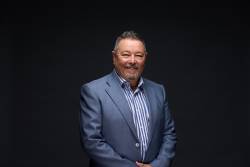A picture of poor health

As the Chair of the Healthcare Otago Charitable Trust, Paul Moodie CFInstD says his board’s value-adding is trying to be the fence at the top of the cliff, not the ambulance at the bottom.
It’s a well-known saying, but especially true in health, with the board constantly striving to improve the health outcomes in communities across a vast area.
Getting people access to healthcare is a massive challenge and cost, with more than 30 per cent of the population across the Southern District Health Board living at least an hour from a hospital. In 2018/19, the SDHB reimbursed more than $1.5 million in travel costs for hospital visits.

Paul Moodie
“I was astounded when we saw the data. We started thinking about better technology in rural hospitals, so people do not have to drive two hours or more, plus take time off work. We’ve battled with this. It’s not easy to overcome,” Moodie says.
“We’re also trying to find a way, with Professor Garry Nixon [a medical practitioner in Central Otago], to influence young medical trainees to get into rural practice, and to support our rural GPs. How do we get them out there? We’re trying to get in front of that.”
Otago also has some of the oldest housing stock and one of the coldest climates in New Zealand, leading to hundreds of children aged 0 to 14 being hospitalised every year with housing-sensitive conditions.
The Trust has invested in the Cosy Homes programme, helping provide basics such as curtains, door stoppers and window seals. “We’re trying to stop reoccurring hospital admissions of young people and the consequences of that for those who are poor,” Moodie says.
Healthcare Otago is an important facilitator of healthcare. The Trust looks after about $24 million and allocates funds each year to charities around the region. Some of those charities are financially fragile, but they offer support to those who would otherwise fall between the gaps. Trusts that are active in the community are constantly pressed for funding – they never have enough, Moodie laments.
“Adding value in those boards is more about investment strategy, making the most of what they’ve got and making tough decisions, such as releasing historic assets and freeing up cash for generations to come to use."
Adding value is trying to find financial stability, getting a strong balance sheet and reoccurring sources of income. The life cycle for a trust is long and most are there for generations to come, unlike many companies. There are also a lot of legacy trusts, many with historic backgrounds and old buildings. Most are always receiving requests.
“They’re asset rich and cash poor,” Moodie says. “Adding value in those boards is more about investment strategy, making the most of what they’ve got and making tough decisions, such as releasing historic assets and freeing up cash for generations to come to use.
“Then you get the trusts that are well-heeled. Their challenge is about how to maintain their money and making sure they get the best use out of it. A lot of that is down to the quality of the applications they receive.
“How do they allocate that money? Do they look for entities that use results-based accountability to prove their outcome in the community? What’s the criteria for giving money away? That can be quite challenging for a board, especially when the need is high. There are always more things that could be done.”
The first rule of thumb, he says, is do your job. That also includes the simple things, such as new trustees understanding their trust and doing their research. Read the deed, he emphasises.
“That clearly states what the trust was set up for. Are you aligned to why the trust was set up? Often that’s not the case, and I call that ‘operational creep’ where successive boards, however well-meaning, try to change or simplify things that aren’t quite working right, and it shifts a little bit. After a decade, you can find that what this board is now doing is quite remote from what they were required to do under the trust.”
At Healthcare Otago, Moodie says they often reflect on, ‘What’s our job?’ What are we there for? Can we make that decision? Is it within our mandate?
“Luckily, on most trusts I’m involved in, one of our trustees is a lawyer who is great at making sure we ‘stay in the lane’.
Moodie is also a believer of ‘leaving it clean’, where decisions are based on the trust’s objectives, policies and procedures, along with its history – and an acceptance you are “simply a guardian for a period of time”.
“You want to ensure the new trustees coming in have the guidance to understand what the trust is doing, how it reports, how it makes decisions, and the stress points around the role.”
Moodie says it is up to the chair to ensure value has been added to a board meeting by reflecting on the decisions that have been made. “There needs to be a natural conclusion to every item on your agenda. I’d normally celebrate those and say we’ve done a great job today in allocating funds.”
Like an athlete warming up for a race, he is a big believer in preparing for a board meeting. “Before a meeting, if you have a chance, reflect on either your strategy or objectives, or your culture. The things that are important to you. It helps to get your head in the game.
“A mental warm-up can bring focus to what your job is and be helpful, especially if you know a topic can be a bit contentious.”
Moodie, who is a senior partner at Findex, also chairs Warbirds Over Wanaka, the international flying extravaganza which returned this year after being forced into a holding pattern since 2018 because of Covid-19.
“Warbirds is an interesting beast in that we only have a show every two years,” Moodie says. “The focus of the board during those years was very much on, ‘how do we survive long enough to get the next show under way?’
“Now I’ve taken over as chair, I want to go back to some of the basics and make sure we’re OK with our purpose, our objectives, our ESG strategy, and our investment strategy. We need to ensure we are clear on all those matters, because without that it is hard to know if you’re adding value.”